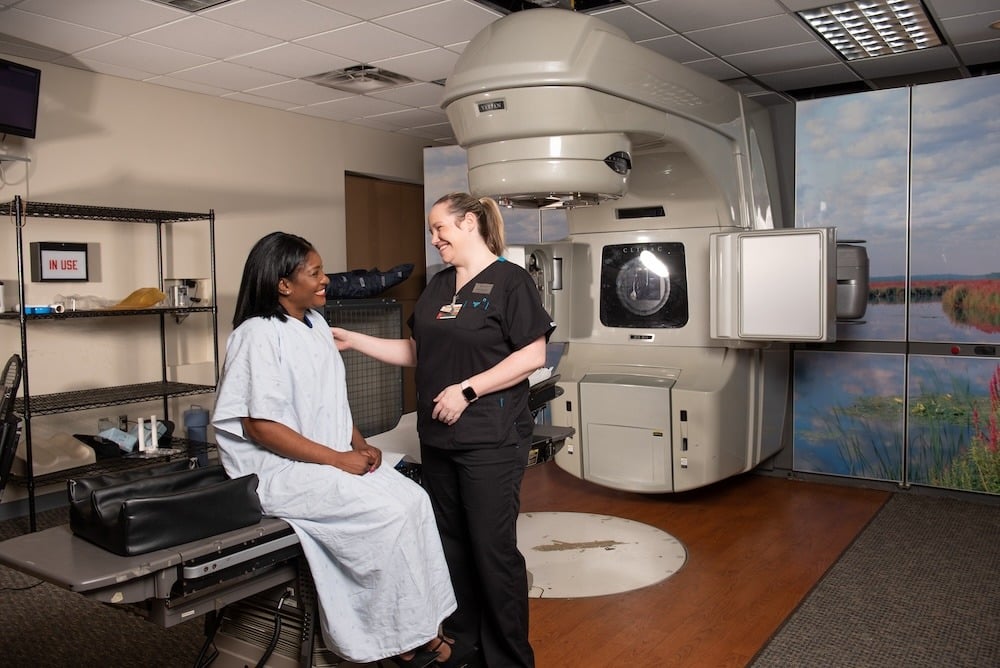
Breast cancer treatment often includes radiation therapy. It can be used to shrink tumors before surgery, and it can be used after surgery to ensure there are no cancer cells left behind in the breast. It can also be used instead of surgery for some patients with very early breast cancer.
There are quite a few different breast radiation technologies available to provide highly precise treatment. Let’s look at the various types and which ones are recommended by radiation oncologists for various patients.
What is Breast Radiation?
Radiation therapy is a treatment that uses high-energy radiation to destroy cancer cells and stop them from growing. It is commonly used after surgery to eliminate any remaining cancer cells in the breast tissues or nearby lymph nodes.
- Partial breast radiation targets only the area around the tumor, typically after a lumpectomy.
- Total breast radiation treats the entire breast and often nearby lymph nodes following a mastectomy or lumpectomy.
If used before surgery, the goal is to reduce the size of the tumor so there is less breast tissue to remove.
External beam radiation therapy is the most common type used for breast cancer. The radiation is delivered from a machine to the breast while the patient lies still on a table. The machine will move around them to direct the beams only to the targeted area.
Internal radiation therapy, called brachytherapy, is also an option for some patients who have early-stage breast cancer.
Various techniques and technologies are available, each with specific uses based on a patient’s unique needs.
Types of Breast Radiation Therapy Technologies
1. Halcyon - IMRT
Halcyon is a modern, image-guided radiation therapy (IMRT) that improves treatment outcomes and provides better patient comfort during treatment sessions. It is designed to precisely target tumors by shaping the beams to the contours of the tumor and adjusting to the patient’s position. This is done by using advanced, real-time imaging that provides a clear view of the tumor throughout treatment. It can also deliver higher radiation doses without causing more side effects. This typically reduces the total number of treatments needed to complete treatment.
2. TrueBeam - SBRT
TrueBeam, a type of stereotactic body radiation therapy (SBRT), is an advanced external beam radiation therapy system that delivers highly targeted radiation therapy from nearly any angle. This is especially helpful for hard-to-reach cancers. TrueBeam also adjusts to the patient’s breathing pattern, ensuring all the radiation is targeted at the tumor. Radiation is delivered quickly using TrueBeam, reducing the overall treatment time and minimizing radiation exposure to surrounding healthy tissue. This reduces the extent of side effects caused by radiation therapy.
3. Image-Guided Radiation Therapy (IGRT)
IGRT combines imaging techniques with radiation therapy to improve the precision of radiation delivery. After completing the treatment planning session, the radiation therapy team will verify the patient's exact position at each treatment session, using images before starting. Adjustments can be made to how the radiation is delivered if the tumor has moved since the last session
4. Volumetric Modulated Arc Therapy (VMAT)
VMAT is a variation of IMRT that allows for continuous radiation delivery while the machine rotates around the patient. It adjusts the beam's shape, and the radiation's strength as the machine continuously rotates. The total treatment time for each session is typically less than 20 minutes.
5. Brachytherapy - APBI
Brachytherapy is internal radiation. For breast cancer, this is referred to as accelerated partial breast radiation. An applicator is placed inside the breast where the tumor was removed. Each day for approximately five days, radioactive “seeds” are placed inside the applicator to deliver radiation from within the breast. This allows for high radiation doses to be delivered over a short period. Some people refer to this as five-day radiation for breast cancer. The exact length of time can vary, but it does not require as many doses as external beam radiation therapy to achieve the results. APBI is used more often in women with early-stage breast cancer.
How Your Radiation Oncologist Chooses the Therapy for You
When considering radiation therapy for breast cancer, the radiation oncologist will review several factors to determine the type that is recommended. Factors include:
- Type and Stage of Cancer: The specific type of breast cancer and the stage can have a major impact on the kind of radiation therapy that will be most effective. Early-stage cancers may be treated with shorter courses of therapy like SBRT or brachytherapy, while more advanced cases will likely use an external bream radiation treatment such as IMRT.
- The Type of Surgery: Most women will need radiation therapy after a lumpectomy to treat the surgery site. Only some will need radiation after a mastectomy, but those who need the technology that’s best suited to whole-breast radiation.
- Tumor Location: The location of the tumor within the breast can determine the most appropriate radiation technique. There will be considerations for preserving the nipple and nearby lymph nodes so that these can be preserved if possible.
- Overall Health: A patient’s overall health and medical conditions can affect treatment options. Some therapies may not be suitable for patients with certain health issues.
- Previous Radiation Treatments: If the patient received radiation therapy previously, whether for another condition or as a part of breast cancer treatment, there will be an assessment of whether the patient will be able to tolerate any additional radiotherapy.
- Patient Preference: Patients may have personal preferences regarding treatment duration, side effects, and overall treatment goals. These concerns should be addressed when creating a treatment plan. You can also discuss travel plans you may have and, if needed, how to coordinate treatment around any upcoming holidays.
The Importance of Collaboration Between Your Breast Cancer Care Team Members
You have the opportunity to choose the radiation oncology team you’d like to use. You will most likely need to go daily for at least a few weeks. The location should be convenient for you. If you live in an Atlanta suburb, it can be hard to get to downtown Atlanta every day – five days a week. Talk to your medical oncology team about where you’d like to receive radiation therapy.
Together, the medical oncology, radiation oncology, and surgery teams will collaborate to:
- Create a plan specifically for you: Your medical oncologist will discuss what’s best for you with the entire team of physicians providing cancer treatment, taking into account the type and stage of cancer, your health, and your personal preferences.
- Avoid and manage side effects: Your radiation therapy team can provide valuable information on what to expect during treatment. This can help you prepare for and manage side effects that are likely to develop. Be sure to inform your radiation oncologist of any new side effects so they can be addressed early.
- Provide continuous support: You may not notice some of the side effects of radiation therapy until after treatment is complete. Or they can worsen for a period after treatment. The radiation oncology team does not stop supporting you when your treatments are done. They will provide support for you and guide you to resources based on your ongoing needs.
Breast Cancer Radiation Therapy Centers Near Atlanta
Remember, you are not alone on this journey. Radiotherapy Clinics of Georgia is there to support and guide you through every step of your treatment and recovery journey. We have radiation therapy locations throughout the Atlanta area equipped with the latest breast cancer treatment technologies. Request a consultation at a center close to you.




